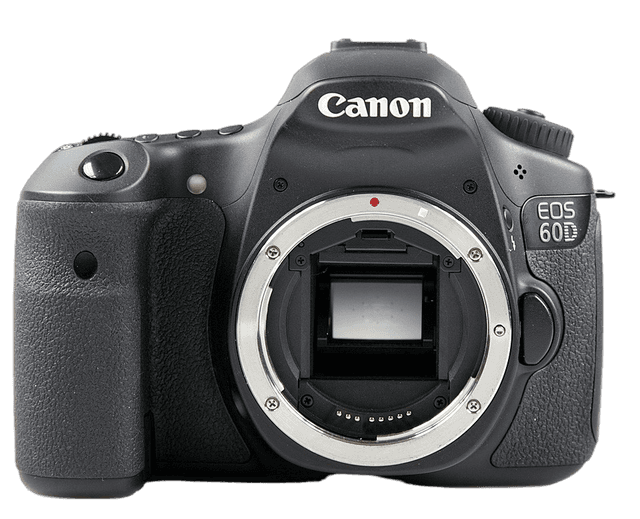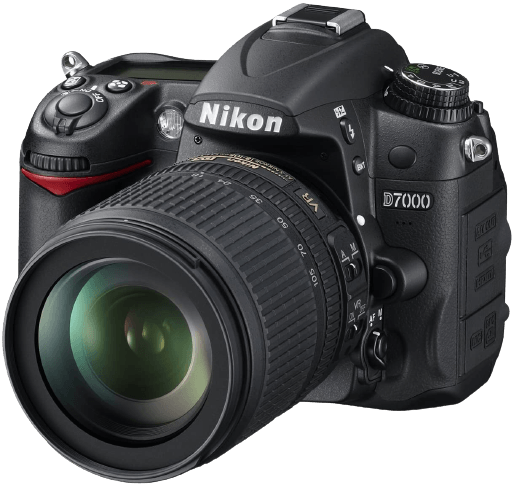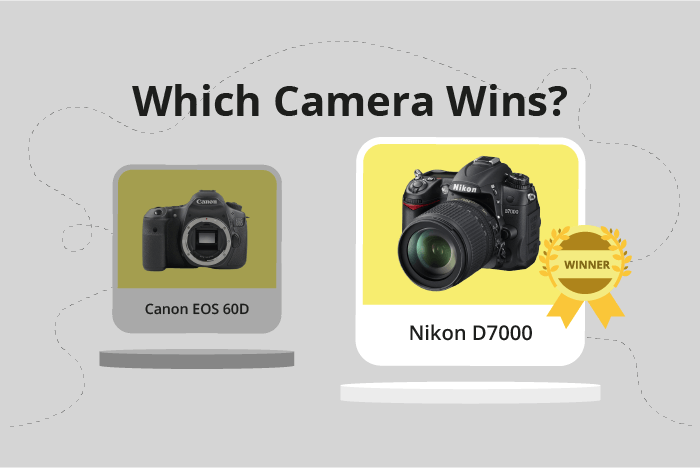Canon EOS 60D vs Nikon D7000 Comparison
Canon EOS 60D

Nikon D7000

The Nikon D7000 outperforms the Canon EOS 60D with a score of 56 compared to 47. Both cameras are DSLRs released in 2010 and had similar launch prices.
The cameras share comparable dimensions, with the Canon EOS 60D measuring 145 x 106 x 79mm and the Nikon D7000 at 132 x 105 x 77mm. However, the Nikon D7000 is slightly heavier, weighing 780g (1.72lbs) compared to the Canon’s 755g (1.66lbs).
Despite the Nikon D7000’s higher score, the Canon EOS 60D has advantages in certain areas, such as being lighter in weight. Ultimately, the Nikon D7000’s higher score reflects its overall better performance and features.
Canon EOS 60D vs Nikon D7000 Overview and Optics
The Nikon D7000 outperforms the Canon EOS 60D in optics, scoring 55/100 compared to the Canon’s 43/100. Both cameras share some common specifications, such as the CMOS sensor type, APS-C sensor size, and the absence of image stabilization. However, there are notable differences that contribute to the Nikon’s higher score.
The Nikon D7000 has a faster shooting speed of 6 frames per second, compared to the Canon EOS 60D’s 5.3. This allows the Nikon to capture more images in a shorter amount of time, making it better suited for fast-paced photography. Additionally, the Nikon D7000’s sensor receives a higher DXOMARK score of 80, while the Canon EOS 60D scores 66. This suggests that the Nikon’s sensor delivers better overall image quality.
On the other hand, the Canon EOS 60D has a higher megapixel count at 18, compared to the Nikon D7000’s 16.2. This means the Canon can capture images with slightly more detail. However, this advantage may not be significant enough to outweigh the benefits provided by the Nikon’s faster shooting speed and superior sensor quality.
Both cameras have their respective lens mounts, with the Canon EOS 60D using the Canon EF-S mount and the Nikon D7000 using the Nikon F mount. This means that each camera has access to a wide range of lenses, allowing for versatility in shooting scenarios.
Considering the differences in shooting speed, sensor quality, and megapixel count, the Nikon D7000 emerges as the better option in terms of optics. While the Canon EOS 60D does offer a slightly higher megapixel count, the Nikon’s advantages in speed and sensor performance make it a more capable camera for capturing high-quality images.
Canon EOS 60D vs Nikon D7000 Video Performance
The Nikon D7000 outperforms the Canon EOS 60D in video capabilities with a score of 57 out of 100, compared to the 60D’s score of 43. Both cameras share common specifications, such as Full HD maximum video resolution and 1920 x 1080 maximum video dimensions. However, the D7000 surpasses the 60D in certain aspects, while the 60D has its own advantages.
The D7000’s superiority in video capabilities is due to its built-in time-lapse functionality, which the 60D lacks. This feature allows the Nikon D7000 to capture a series of images at set intervals, which can be combined to create a time-lapse video. This is particularly useful for capturing events that occur slowly over time, such as the movement of clouds or the blooming of a flower.
On the other hand, the Canon EOS 60D offers a higher maximum video frame rate of 30fps, compared to the D7000’s 24fps. This means that the 60D can record smoother video with less motion blur, especially when capturing fast-moving subjects or action scenes.
In conclusion, the Nikon D7000 is the better choice for those interested in creating time-lapse videos, as it has built-in time-lapse functionality. The Canon EOS 60D, however, is better suited for capturing smoother video with its higher frame rate. Ultimately, the choice between these two cameras depends on the specific video needs and preferences of the user.
Canon EOS 60D vs Nikon D7000 Features and Benefits
The Canon EOS 60D outperforms the Nikon D7000 with a feature score of 57/100 compared to Nikon’s 54/100. Both cameras share some common specifications, such as a 3-inch screen size and the absence of a touchscreen, GPS, and Bluetooth capabilities.
The Canon EOS 60D stands out due to its higher screen resolution of 1,040,000 dots compared to the Nikon D7000’s 921,000 dots. Additionally, the EOS 60D has a flip screen, providing more flexibility and convenience for photographers when capturing images from various angles. This feature is not present in the Nikon D7000.
On the other hand, the Nikon D7000 has built-in WiFi, which allows for easy transfer of images and remote camera control. The Canon EOS 60D lacks this feature. However, this advantage does not outweigh the benefits of the EOS 60D’s higher screen resolution and flip screen.
Based on the comparison, the Canon EOS 60D has a slight edge over the Nikon D7000 due to its superior screen resolution and flip screen feature. These enhance the user experience and provide more options for photographers. The Nikon D7000’s built-in WiFi is a valuable addition, but it does not significantly impact the overall performance and functionality of the camera compared to the Canon EOS 60D. Therefore, the Canon EOS 60D is the better choice in terms of features.
Canon EOS 60D vs Nikon D7000 Storage and Battery
The Canon EOS 60D and Nikon D7000 share similarities in storage and battery, including support for SD/SDHC/SDXC memory cards, and no USB charging capability. The D7000 offers a competitive edge with its dual memory card slots.
The Canon EOS 60D has a slight edge in battery life, providing 1100 shots per charge, compared to the Nikon D7000’s 1050 shots. The 60D uses the LP-E6 battery type, contributing to its longer battery life.
On the other hand, the Nikon D7000 holds its ground with its EN-EL15 battery type, which, although having a slightly shorter battery life, still offers a substantial number of shots per charge.
Canon EOS 60D vs Nikon D7000 – Our Verdict
Are you still undecided about which camera is right for you? Have a look at these popular comparisons that feature the Canon EOS 60D or the Nikon D7000:

